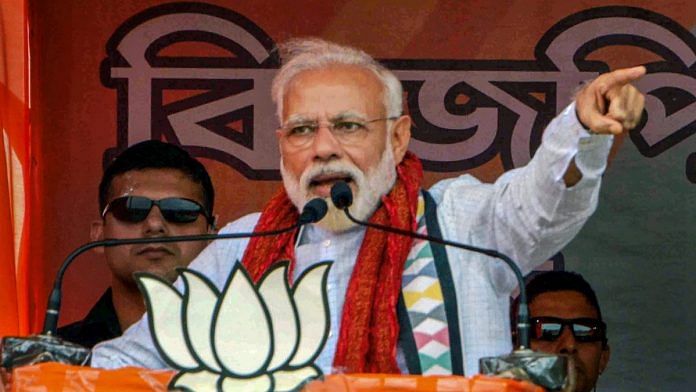A few days ago, when talking to an the assembled chief ministers of India’s states, Prime Minister Narendra Modi declared that he wanted India to be a “$5 trillion economy” by 2024, when he once again faces reelection. This would, he said, be “challenging, but achievable.”
Modi could never be accused of lacking ambition, but the fact is that getting India’s GDP to $5 trillion in five years will be far more challenging than achievable. India is, currently, a $2.8 trillion dollar economy; to reach the $5 trillion mark by 2024, the economy would have to grow at over 12% a year. To put this in context, in the last quarter for which data is available, India grew at slower than 6% — and, if you believe the Modi government’s own former top economist, that data is flawed and India may well be growing a few percentage points less than that.
India could and should aspire to double-digit growth. Without sustained growth at that level it has little hope of employing the roughly one million young people who join its workforce every month. And unless it takes advantage of its current, favorable demographics it is never likely to emerge as an upper-middle-income economy with a prosperous and thriving middle class.
But the prerequisites for the kind of growth that transformed the fortunes of the Asian tigers and then China have not yet been put into place. Supportive markets for land and labor simply do not exist. Energy supply and infrastructure are far better than they were, but still not up to the standards required to build a world-class manufacturing sector. And although successive governments have paid lip service to the need to educate young Indians and provide them with the vocational skills they need to succeed in a modern economy, the outcomes of various attempts to do so have been frankly disappointing.
If India does very little — a “business-as-usual” scenario — it will, indeed, continue to grow. Growth will be moderate by Indian standards — between 5% to 8% on average, and more often around 6%. If it does in fact grow at 6% a year, then the Indian economy will hit $5 trillion in output a decade from now, twice the time that Modi wants.
It will also be a very different economy — and country — from others of that size. The India of 2029, if it is still growing at 6%, will be vastly unequal not just in terms of personal income and wealth, but between regions. Some parts of India — the southern peninsula, the national capital of Delhi, and the coastal regions of Gujarat and Maharashtra — may by then have achieved relatively well-off, middle-income status.
But the vast hinterland of India — which is also, incidentally, where population growth is highest — will remain poor. These are the areas that have, for the past two general elections, determined the composition and orientation of India’s national government. Their power within Indian politics will only grow, and India’s behavior toward the rest of the world will reflect their attitudes and priorities.
Even today, parts of India look like Southeast Asia and other parts like sub-Saharan Africa. That difference will intensify in the absence of double-digit growth. The centrifugal forces this will set off — already visible in Indian politics — may be severely destabilizing.
Nor will this India have the kind of state that is generally associated with large and dynamic economies. The Indian state today remains under-resourced and under-powered. It is set up more for a large agrarian economy than it is for global production or sophisticated manufacturing. It struggles to implement large-scale infrastructure projects or to regulate complex sectors independently and transparently. Nor will it have the money for a defense sector in keeping with Indians’ high expectations, or the world’s.
How will the world deal with a country that has the aggregate size, and the aspirations, of a putative superpower but whose politics, state and capabilities have remained relatively unchanged? It will not be easy. Other countries have graduated, one way or another, from developing-country status. What happens when India becomes one of the three or four largest economies in the world in dollar terms, but retains the attitudes and requirements of a developing country?
The rest of the world had better hope that Modi’s ambitions of high growth are fulfilled. That will mean that India has carried out the crucial internal reforms that will allow it to be a productive international player, and to take on the leadership roles that so many people across the world hope that it will. But the chances of that happening at the moment are sadly low.
Also read: ‘Spurious criticism’ — PM’s economic council rebuts Arvind Subramanian’s GDP claim







I expected some constructive suggestions to achieve the ambitious target.Could not see one.
The rest of the world sees India without blinkers or rose tinted glasses. The Western media is uniformly critical. Ambassadors from our smallest neighbours, posted in Chanakyapuri, must be among the best informed people about how well India and its economy are doing. The same applies to multinationals and other large investors. Put your house in order and come to us, we know your potential but will wait to see you start unlocking it more effectively. Indian diplomats, posted in Delhi and abroad, would be acutely conscious of the fact that we are no longer flavour of the season.
On a lighter note, after Dr A S’s surgical strike, we cannot even ask the statisticians to get us there.